Key points:
- Demand for care workers is high, with searches in Indeed’s database for ‘care assistant’ increasing to over 10% of all CV searches in April.
- Advertised pay remains low, with the median wage in carer job postings £9.50 an hour in April, up just 20p since before the crisis.
- Some 42% of advertised social care wages across the UK and 67% in London are below the Real Living Wage.
Carers have earned public admiration and gratitude amidst the Covid-19 crisis, but that regard isn’t translating into significantly bigger pay packets in this notably low-paying occupation. Our analysis of thousands of new social care jobs posted in April 2020 shows that the median advertised wage is £9.50 an hour, up just 20p since before the crisis. And that small rise is due largely to the increase in the UK’s minimum wage at the start of the month. We may clap for carers and other essential workers, but 42% of advertised social care wages remain below the Real Living Wage.
Low pay in the care sector is a long-standing issue. What’s surprising is that it persists despite high demand for care workers and the difficulties of attracting people to the field. Recent efforts to boost the adult social care workforce by providing information, training, health checks and protective equipment are a step in the right direction. But there is still lots of room for improvement in pay and working conditions. That is a problem for the government to address, given extensive public funding of social care.
Demand for care workers is high
Job postings for care workers have held up better than most other occupations during the pandemic. While hiring in shuttered sectors like hospitality and travel has all but dried up, social care jobs — such as positions for support workers and care assistants, the workers who provide services in people’s homes or in care homes — are posted on Indeed every day. To be sure, social care postings are down 24% from 1 February to 1 May. But that is much less than the 54% overall drop in job postings.
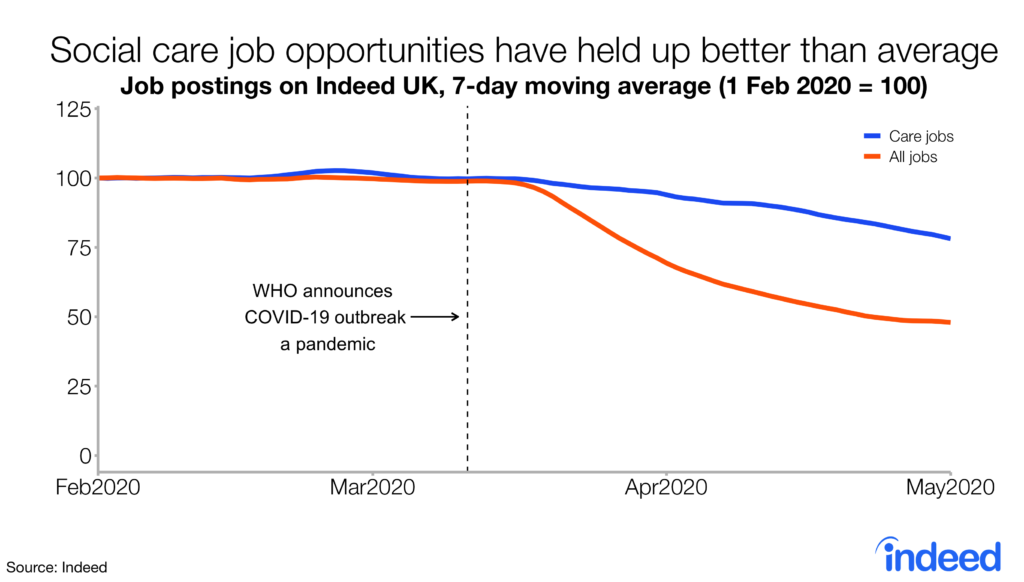
Recruiters are keen to hire care workers, perhaps because of Covid-19 effects. In a recent survey, one-third of social care employers reported an urgent and immediate need for staff. Meanwhile, searches in Indeed’s CV database for the phrase ‘care assistant’ – one of the most common social care job titles – increased in early April from less than 5% to over 10% of all CV searches. While experienced candidates are less likely to switch jobs in an economic downturn than when the times are good – and care workers may be especially reluctant to leave their customers behind in a health crisis – this trend shows that interest in hiring care workers is high.
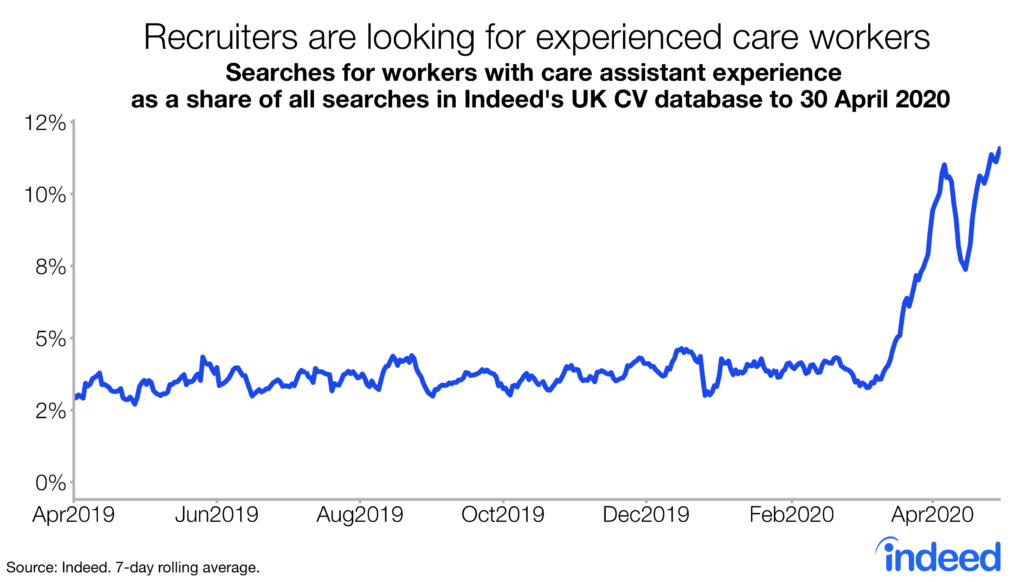
Despite high demand for care workers, advertised pay stays low
You might think that rising demand would translate into bigger pay packets for social care workers. But that is not the case. Advertised wages for new carers or those switching jobs have hardly budged since the onset of the Covid-19 crisis. New care jobs posted on Indeed in April 2020 advertised a median wage of £9.50 an hour — just 20p more than before the lockdown.
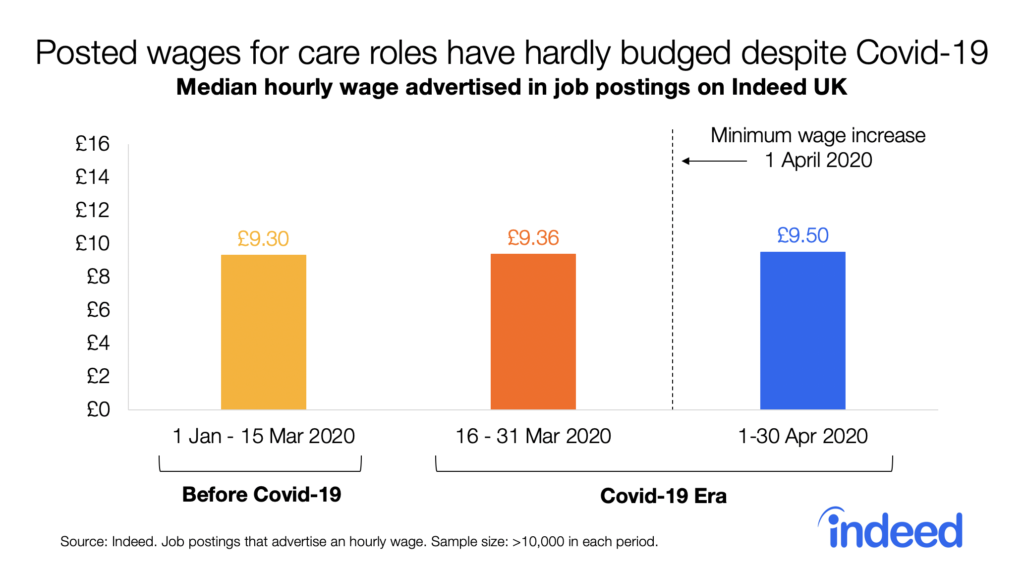
That small rise in advertised pay appears to reflect the minimum wage increase from £8.21 to £8.72 an hour for people 25 and over at the start of April rather than developments specific to the care sector. This is demonstrated by the fact that the largest increase — 39p — was for jobs that pay the minimum wage.
Increases at higher pay brackets were smaller and no change occurred at the top of the pay distribution. This is consistent with the observation that, in low-paid occupations, minimum wage increases often lead to small raises throughout the pay structure because some employers want to maintain pay differentials within their workforce.
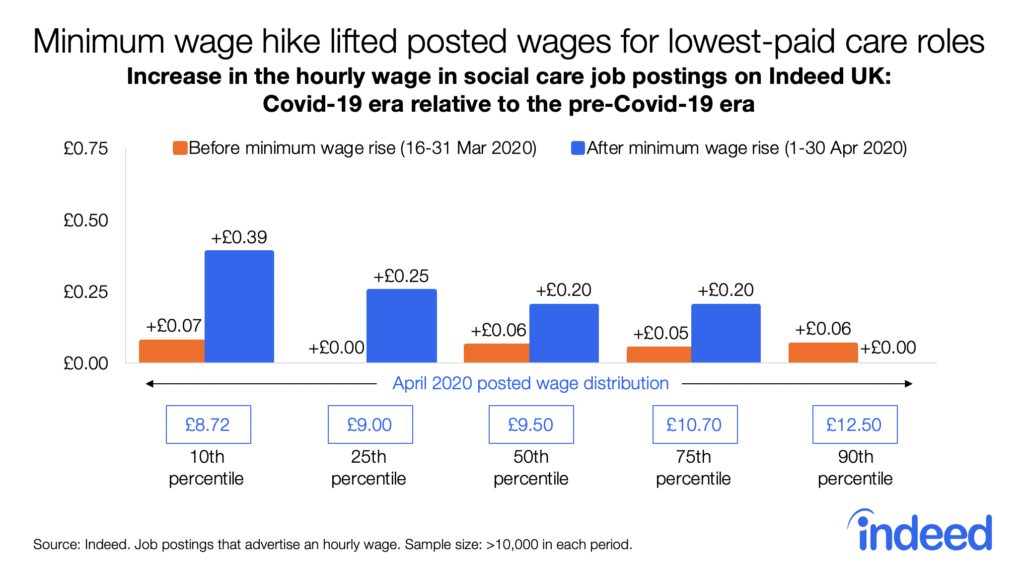
Despite the minimum wage increase, pay in social care continues to be strikingly low. The Real Living Wage is currently £10.75 an hour in London and £9.30 an hour outside London. A full 42% of new social care jobs posted on Indeed in April advertised a wage lower than those levels. In London, the gap is especially stark: 67% of advertised wages are below the Real Living Wage compared with 41% in the rest of the UK.
Jobseekers aren’t flocking to care jobs
This stagnant pay is surprising given the difficulty of attracting people to work in care. That difficulty is demonstrated by recent trends in job posting clicks. Clicks per job posting in the social care sector outpaced the average for all jobs by 15% between February and May but lagged the three occupations that saw the largest relative increases in clicks per posting in the same period: driving at 108% growth compared to the average, agriculture at 107% and loading & stocking at 87%. This divergence isn’t driven by seasonal effects because clicks per posting in the four occupations moved together during the same period last year.
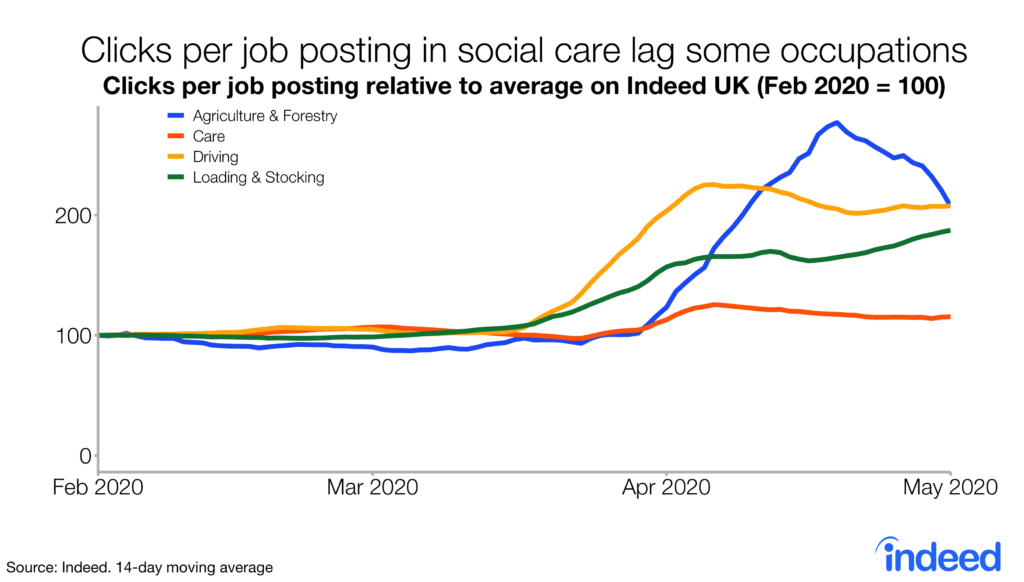
Address the social care recruitment challenge by improving pay
Solutions to the problem of recruiting social care workers require attracting more candidates to the sector. To accomplish that, it is important to understand the motives of those considering social care work.
There may be plenty of nonmonetary reasons why more jobseekers aren’t clicking on care jobs, such as personal preference, a lack of qualifications or worries about health risks. Moreover, references, criminal checks and training are often required parts of the hiring process. This means that barriers to entry are greater in social care than in many other sectors that offer immediate employment opportunities during this crisis.
Nevertheless, in normal times, people’s number one work-related concern is pay. Jobseekers on Indeed flock to employers that announce pay increases. Today, even in extraordinary circumstances, pay offered to care workers remains low. That could be one of the reasons why jobseekers aren’t clicking on care jobs in greater numbers. And that is unfortunate when the need for carers is so urgent.
Methodology
Salary data are from job postings with hourly wages on Indeed UK between 1 January and 30 April 2020. During this period, 77% of social care job postings with salary information specified an hourly wage rather than an annual salary or another rate. When a job posting specifies a range (e.g., £9.50-£10.50 an hour), we use the midpoint.
Using regression analysis, the 20p increase in average posted wages for care workers over the period analysed is statistically significant and is robust to controlling for compositional changes in social care job postings, such as a shift towards more or less senior job titles over time.
To measure the trends in job postings, we calculated the seven-day moving average of the number of UK job postings on Indeed. We indexed each day’s seven-day moving average to the 1 February = 100. Data on job postings is based on publicly available information on the Indeed UK website and limited to the UK. It is not a projection of future events and includes both paid and unpaid job solicitations.






